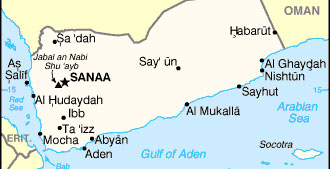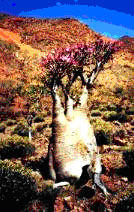The Socotra Archipelago is located 350km south of the Arabian Peninsula. The archipelago consists of the main island of Socotra (3625 km sq) and three smaller islands, Abd Al Kuri, Samha and Darsa, and other rock outcrops. The islands are part of Yemen.
About 100 people live on Samha (10x5 km), 300 on the larger Abd Al-Kuri is larger (25x5 km). The island of Darsa is not inhabited.
Being virtually isolated from the rest of the world, the island has Arabia’s greatest plant and animal diversity; many animals and plants that live today on Socotra are found nowhere else on earth. Botanists rank Socotra among the top ten endangered islands in the world. There are more than 800 species of plants, some 240 of which are endemic to the island.
One of the most famous plants is the Dragon's tree, the bark oozes a deep red liquid if cut. Bottle trees are abundant and have pink flowers after the rains. Cucumber trees, relatives of the melon, provide food for animals during times of drought.
From June to September the island is accessible only by plane, because of the strong monsoon winds and access by sea is impossible due to high seas and winds all around the island. The fishermen move from their seaside to the mountains during this season and harvest their date palms.
The monsoon winds have also forced insects to adapt; Socotran insects have evolved relatively small wings which prevents them from being blown out to sea. Centipedes can reach a length of more than 20 centimeters, and huge spiders spin yellow webs across woodland gaps. At least 80% of Socotra's reptiles are endemic.
Birdlife International has identifies over 22 "Important Bird Areas" on the Socotra Archipelago. About 140 species of birds have been recorded, among them the Socotra Bunting, Socotra Starling, Socotra Sunbird, Socotra Sparrow, Socotra Warbler, and Socotra Cisticola, all of which are unique to the island. The Egyptian Vulture, known locally as al Baladiya Socotri is known (and appreciated) for its habit of cleaning up everything from kitchen waste to human waste.
Marine life around the archipelago includes a number of species of hard corals and fish.
In July of 1999, a new airport opened on Socotra, which has made the archipelago easily accessible after centuries of isolation. Development is bringing positive changes to the lives of the local population but at the same time development threatens the uniqueness of the islands’ diversity. The Yemeni government is working with environmentalists to set guidelines for conservation and sustainable development of the islands. The initial plans call for most of the islands and surrounding waters to be designated a National Park, with Socotri natives managing the eco-tourism and natural resources.
photos used with permission: www.ftiyemen.com





